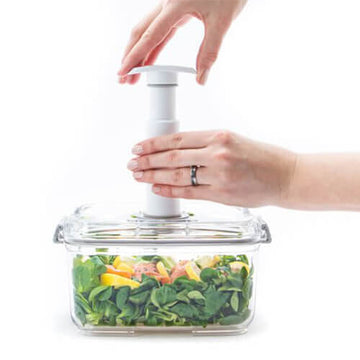Proper use of vacuum canisters
Using vacuum canisters properly. Does your food vacuum container release the vacuum in a few days? Having trouble vacuuming with a hand pump because you’re not sure how much air needs to be sucked out? Read our tips below and enjoy quality fresh food and an organized food storage system.
PROBLEM 1: The vacuum in the container drops in a few hours or a few days.
You must first determine if the reason for lowering or loosing the vacuum. Is it the food that you have stored in the container or damage to the container itself.Some food release gases during storage because they mature. This causes the vacuum to loosen. Such foods are e.g. onions, garlic, apples and soft cheeses. For these foods, we recommend that you check the vacuum once a day and redo it if necessary. Another reason may be a crack in the vacuum container or lid or even damaged seals and valve. Cracks and damage may be invisible to the naked eye, but they cause air to leak, so the vacuum eventually releases. We recommend that you first determine the cause of the leak with a
water test. Fill the vacuum container half way with water and then vacuum the container. Observe where bubbles appear. Also turn the container around and check for air leaks on the lid. The test will show if the problem is in a cracked container, lid, or damaged seals. Once the damage has been located the parts can be replaced and the container reused. Some fresh fruits and vegetables still ripen during storage and release gases that affect the vacuum.
PROBLEM 2: You cannot vacuum the container
For large containers (3 and 4.5 liters) it is necessaryto press the lid a little at the beginning to seal the container and create an initial vacuum.
Normally, the pressure you apply when you place the pump in the groove and pump the air is enough. If, despite the correct installation of the lid on the container, you fail to create a vacuum, the problem may be in damage to the seal or dirty seals.
Check that the
seals are dry, free of food residue, undamaged and properly installed.
If you need to replace the seals, contact us.
The problem can also be dirt in the valve. Remove the valve and check that everything is as it should be – dry, with no food residue.
Also, do not overfill the container – the top of the food should reach a maximum of 3 cm from the top edge of the container.
This will prevent the valve from getting dirty and food from entering the valve.
The reason you can’t vacuum a container can also be damage to the food vacuum container, which can be so small that you can’t even see it with the naked eye. To check if the container is damaged, we recommend the water test described above.
Fill the container up to about 3 cm from the top edge to prevent food from coming into contact with the valve.
PROBLEM 3: Not sure how many strokes with a hand pump are needed to vacuum the container
The number of strokes with a hand-held vacuum pump depends on the volume of food in the vacuum container. We recommend that you always use a proportional size vacuum container according to the size of the food.
With the usual filling of the container, somewhere up to 3 cm from the edge (except for smaller containers), 5 – 10 strokes with a manual vacuum pump will suffice . You will feel a slight drag when pulling and a slight concavity of the container and lid.
To solve this problem, we also developed a vacuum indicator on the full Tritan vacuum containers. The green indicator on the cover tilts when the optimum vacuum is reached.
All our sets have an indicator on the lid 
Full Tritan vacuum vessels have a built-in vacuum indicator that concaves when the optimal vacuum is reached.
PROBLEM 4: Some foods spoil quickly despite being vacuum stored in the refrigerator
Certain foods are sensitive to excess moisture and spoil quickly. They turn black and rot despite being vacuum sealed.
Drainers for vacuum vessels
When storing cleaned lettuce and other leafy vegetables, sliced cucumbers, berries, string beans and pineapple, we recommend using drainers in containers. These prevent food from coming into contact with excess liquid and ensure longer shelf life of sensitive foods. Drainers are also great for storing cakes , as they flatten the bottom of the container, so your cake is stable and also suitable for carrying and serving to guests
Tritan Canisters 3L and 4.5L 
Drainers in vacuum containers ensure that excess liquid drains away from food.
PROBLEM 5: The handles of the containers come out
The grey handles on the covers are designed so that they can be easily attached and removed during the assembly process. Due to this design, it can occur that they sometimes come out, even when storing the lids when they are not in use. We recommend that you store the covers with the handles raised or removed. And finally, we give you this trick: you can vacuum the containers even if the lids do not have handles, as the lids suck on the container due to the vacuum and close it securely.When closing and opening the container, always close and open the handles at the same time. Turn them upside down or horizontally during storage.



2 comments
Yes the canisters are freezer safe
Hello, I’m just wondering if you can put the Munro vacuum seal containers in the freezer.
Many thanks.
Cheers
Lana 🙂